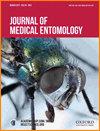Widespread geographic distribution of Aedes aegypti (Diptera: Culicidae) kdr variants in Panama
IF 2
3区 农林科学
Q1 ENTOMOLOGY
引用次数: 0
Abstract
We searched for evidence of knockdown resistance (kdr) mutations in the voltage-gated sodium channel gene of Aedes aegypti (Linnaeus) (Diptera: Culicidae) and Aedes albopictus (Skuse) (Diptera: Culicidae) mosquitoes from Panama. Conventional PCR was performed on 469 Ae. aegypti and 349 Ae. albopictus. We did not discover kdr mutations in Ae. albopictus, but 2 nonsynonymous kdr mutations, V1016I (found in 101 mosquitoes) and F1534C (found in 29 of the mosquitoes with the V1016I), were detected in Ae. aegypti. These kdr mutations were present in all specimens that were successfully sequenced for both IIS5-S6 and IIIS6 regions, which included samples collected from 8 of the 10 provinces of Panama. No other kdr mutations were found in Ae. aegypti, including V1016G, which has already been reported in Panama. Findings suggest that the V1016I-F1534C variant is prevalent in Panama, which might be related to the introduction and passive movement of mosquitoes as part of the used-tire trade. However, we cannot rule out the possibility that selection on de novo replacement of kdr mutations also partially explains the widespread distribution pattern of these mutations. These 2 ecological and evolutionary processes are not mutually exclusive, though, as they can occur in tandem. Research in Panama needs to calculate the genotypic and allelic frequencies of kdr alleles in local Ae. aegypti populations and to test whether some combinations confer phenotypic resistance or not. Finally, future studies will have to track the introduction and spreading of new kdr mutations in both Aedes species.巴拿马埃及伊蚊(双翅目:库蚊科)kdr变种的广泛地理分布
我们在巴拿马的埃及伊蚊(Linnaeus)(双翅目:Culicidae)和白纹伊蚊(Skuse)(双翅目:Culicidae)的电压门钠离子通道基因中寻找基因敲除抗性(kdr)突变的证据。对 469 只埃及伊蚊和 349 只白纹伊蚊进行了常规 PCR 检测。我们没有在白纹伊蚊中发现 kdr 突变,但在埃及伊蚊中发现了 2 个非同义 kdr 突变,即 V1016I(在 101 只蚊子中发现)和 F1534C(在 29 只带有 V1016I 的蚊子中发现)。这些 kdr 变异出现在所有 IIS5-S6 和 IIIS6 区域测序成功的样本中,其中包括从巴拿马 10 个省中的 8 个省采集的样本。在埃及蝇中没有发现其他 kdr 变异,包括在巴拿马已有报道的 V1016G。研究结果表明,V1016I-F1534C 变异在巴拿马很普遍,这可能与旧轮胎贸易中蚊子的引入和被动移动有关。然而,我们不能排除这样一种可能性,即对 kdr 突变的从头替换的选择也部分解释了这些变异的广泛分布模式。不过,这两个生态和进化过程并不相互排斥,因为它们可以同时发生。巴拿马的研究需要计算 kdr 等位基因在当地埃及蚁种群中的基因型和等位基因频率,并检验某些组合是否会产生表型抗性。最后,未来的研究必须跟踪新的 kdr 突变在两种伊蚊中的引入和传播情况。
本文章由计算机程序翻译,如有差异,请以英文原文为准。
求助全文
约1分钟内获得全文
求助全文
来源期刊
CiteScore
4.60
自引率
14.30%
发文量
207
审稿时长
3-8 weeks
期刊介绍:
Journal of Medical Entomology is published bimonthly in January, March, May, July, September, and November. The journal publishes reports on all phases of medical entomology and medical acarology, including the systematics and biology of insects, acarines, and other arthropods of public health and veterinary significance. In addition to full-length research articles, the journal publishes Reviews, interpretive articles in a Forum section, Short Communications, and Letters to the Editor.

 求助内容:
求助内容: 应助结果提醒方式:
应助结果提醒方式:


